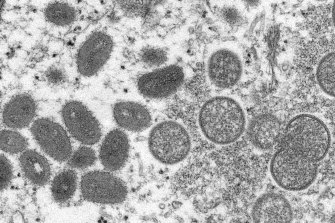Monkeypox cases among gay, bisexual men reported in Portugal, Britain
May 19, 2022 — 5.31am
By Maria Cheng and Barry Hatton
Lisbon: Portuguese health authorities confirmed five cases of monkeypox in young men, and Britain announced another two, marking an unusual outbreak in Europe of a disease typically limited to Africa.
Portugal’s General Directorate for Health said it was also investigating 15 suspected cases and that all were identified this month in the area around the capital, Lisbon.
Monkeypox virions obtained from a sample of human skin associated with the 2003 prairie dog outbreak.APnone
All the Portuguese cases involve men, most of them young, authorities said, on Wednesday, Portugal time. They have skin lesions and were reported to be in stable condition. Authorities did not say if the men had a history of travel to Africa or any links with recent cases in Britain or elsewhere.
British health authorities said on Wednesday they had identified two new cases of monkeypox, one in London and another in south-east England. They said neither case had previously travelled to Africa and that it was possible they were infected in Britain. The cases had no known links to other previously confirmed patients, suggesting there may be multiple chains of monkeypox transmission already happening in the country.
Dr Susan Hopkins, chief medical adviser of Britain’s Health Security Agency, said the latest cases, alongside the other infections reported in Europe, “confirms our initial concerns that there could be spread of monkeypox within our communities”.
The agency said recent cases had been seen “predominantly in gay, bisexual or men who have sex with men”, although it noted it was unclear how exactly people had been infected.
Monkeypox has not previously been documented to have spread through sex, but can be transmitted through close contact with infected people, their clothing or bedsheets.
Earlier this week the UK agency reported four cases of monkeypox they said had been spread among gay and bisexual men in London. The agency said the risk to the general population “remains low”.
Health authorities in Spain’s central Madrid region said late on Wednesday that they were assessing 23 possible cases of monkeypox. They noted that all of the suspected cases are young men and that the majority of them had sex with other men.
The disease belongs to a family of viruses that includes smallpox. Most people recover from monkeypox within weeks, but the WHO said that the disease is fatal for up to one in ten people.
Sporadic cases of monkeypox have been seen previously in countries including Britain and the US, but nearly all have been in people who were likely infected during their travels in Africa.
Dr Ibrahim Soce Fall, the World Health Organisation’s assistant director-general for emergency response, said the spread of monkeypox in the UK needed to be investigated to understand how the disease was being transmitted among men who have sex with other men.
Fall said that health officials still need a better understanding of how monkeypox spreads in general, even in the countries where it is endemic.
He noted that while there were more than 6000 reported cases in Congo and about 3000 cases in Nigeria last year, there are still “so many unknowns in terms of the dynamics of transmission.”
Britain previously reported three earlier cases of monkeypox, two involving people who lived in the same household and the third someone who had travelled to Nigeria, where the disease occurs frequently in animals.
The virus has typically spread to people from infected animals like rodents, although human-to-human transmission has been known to occur.
Some British experts said it was soon to conclude that monkeypox had spread through sexual contact, although the outbreak there suggested that possibility.
“The recent cases suggest a potentially novel means of spread,” Neil Mabbott, a disease expert at the University of Edinburgh, said, adding that related viruses were known to spread via sex.
Keith Neal, an infectious diseases expert at the University of Nottingham, said the transmission might not have occurred through sexual activity but just “the close contact associated with sexual intercourse.”
Monkeypox typically causes fever, chills, a rash and lesions on the face or genitals resembling those caused by smallpox. A vaccine developed against smallpox has been approved for monkeypox, and several anti-virals also appear to be effective.












